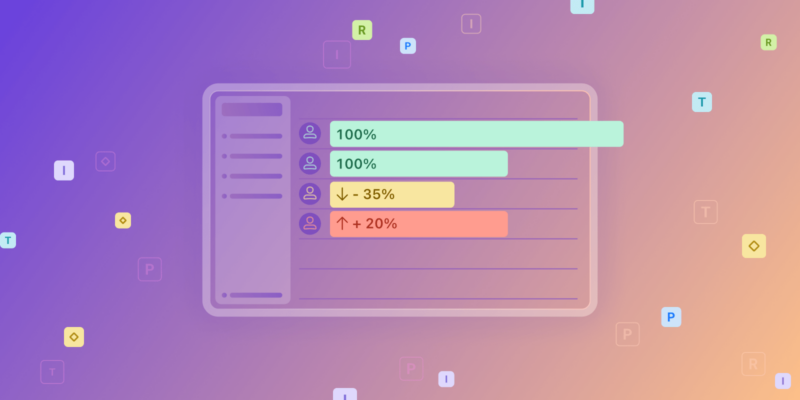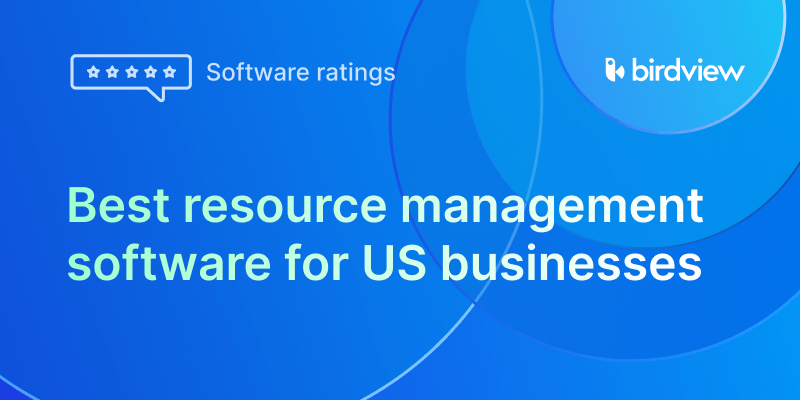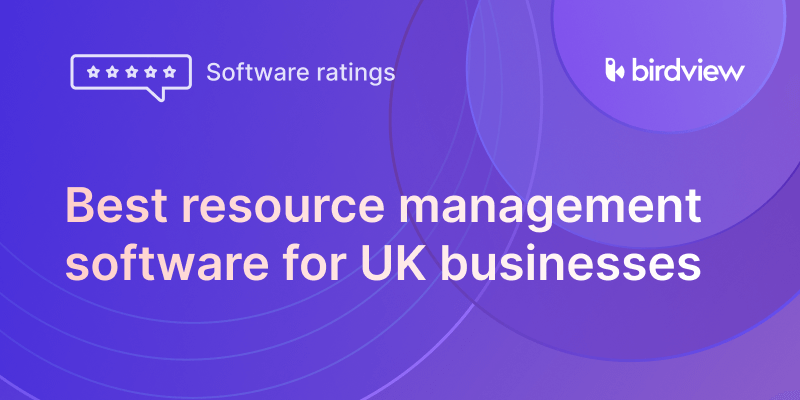Enterprise resource planning (ERP) and enterprise resource management (ERM) aren’t just buzzwords or expensive software solutions that consultants push on unsuspecting businesses. They’re the difference between scaling successfully and being overwhelmed by operational complexity.
What is enterprise resource planning?
Enterprise resource planning (ERP) is a system that organizations use to manage and integrate their core business functions. Think of it as the digital backbone connecting finance, HR, procurement, operations, and more into one cohesive system.
Modern ERP systems are like having a central nervous system for your business. Take a marketing agency: before ERP, project managers manually tracked time across different tools, finance struggled with accurate invoices, and leadership lacked real-time project profitability insights. With ERP, time tracking feeds directly into budgets, invoices generate automatically, and dashboards provide instant insights into profitable projects and valuable clients.
What is enterprise resource management?
Now, if ERP is the system, then enterprise resource management (ERM) is the strategy. ERM is the ongoing process of planning, allocating, and optimizing all resources across an organization.
The goal of ERM is visibility, utilization, efficiency, and balance. It’s about understanding what you have, where it’s being used, how effectively it’s being deployed, and where adjustments need to be made.
ERM is fundamentally about understanding your constraints and optimizing within them. Every business has limited resources. The question is whether you’re using them as effectively as possible.
How enterprise resource planning and management work together
Here’s where the magic happens: when ERP systems and ERM processes work in harmony, they create something greater than the sum of their parts. ERP collects and organizes data, while resource management uses that data to make intelligent decisions. It’s a continuous feedback loop.
Example: A consulting firm’s ERP system tracks which consultants work on which projects and their utilization rates. When the resource manager notices three senior consultants are underutilized while two juniors are overloaded on key projects, she can immediately reallocate work by assigning a senior to support the juniors and redistributing tasks. Without ERP, this imbalance might go unnoticed for weeks.
Benefits of enterprise resource planning and management
This alignment between ERP systems and resource management creates several powerful outcomes. The benefits of integrated ERP and ERM go far beyond just “having better data”. Let’s break down the real-world advantages that organizations see when they get this right.
- Integrated data: breaking down the silos
ERP eliminates data silos, making all departments work from the same source of truth. Sales updates, HR changes, or capacity adjustments are visible instantly to operations and finance, keeping everyone aligned.
- Increased visibility: real-time insights that matter
Dashboards and reports show KPIs, workloads, and resource availability as they happen. Managers don‘t wait for month-end reports. They see performance in real time.
- Better forecasting: planning with confidence
With accurate historical data on timelines, utilization, and costs, forecasting becomes reliable. Teams can predict demand, plan workforce needs, and create financial forecasts with confidence.
- Higher efficiency: automation that scales
ERP automates invoicing, reporting, and resource allocation. This saves time, reduces errors, and frees teams from repetitive manual work.
- Scalability: growing without breaking
ERP grows with your business, managing more complexity without adding extra admin. Organizations can expand operations while staying in control.
- Industry-specific benefits
Different industries see different advantages:
- Services companies (e.g. business consulting, engineering, IT services, etc.) achieve better staffing accuracy and more precise billing, reducing both over-allocation and revenue leakage.
- Manufacturing companies streamline production and procurement, reducing inventory costs while improving delivery times.
- Healthcare organizations optimize scheduling and inventory control, improving patient care while controlling costs.
Challenges and risks to enterprise planning and management
Let’s be honest about something that vendors don’t always emphasize: implementing ERP and resource management systems is hard. Really hard. And the bigger your organization, the harder it gets.
- Complex implementation: ERP implementations are notorious for taking longer and costing more than planned because organizations underestimate their process complexity until mapping them into a new system.
- Change resistance: The hardest part isn’t technical – it’s human. Employees resist new processes even when they’re objectively better, which is natural psychology, not stubbornness.
- Integration difficulties: Legacy systems, custom databases, and years of accumulated data don’t always integrate smoothly with new ERP systems.
- Cost overruns: Organizations inevitably discover additional features or overlooked processes during implementation. Those who define scope upfront and have formal change approval processes manage this best.
- Poor data quality: ERP systems are only as good as your data. Incomplete or inconsistent data gets magnified in the new system, making data cleanup essential but time-consuming.
- Overreliance on tools: ERP systems are tools, not solutions. They can’t replace sound decision-making or leadership. They should support and enhance human judgment, not replace it.
What is an ERP system?
Now that we understand the concepts, let’s get practical. An ERP system is a software suite that integrates all major business functions into one unified platform. Instead of using separate software for different departments, everyone works within the same ecosystem.
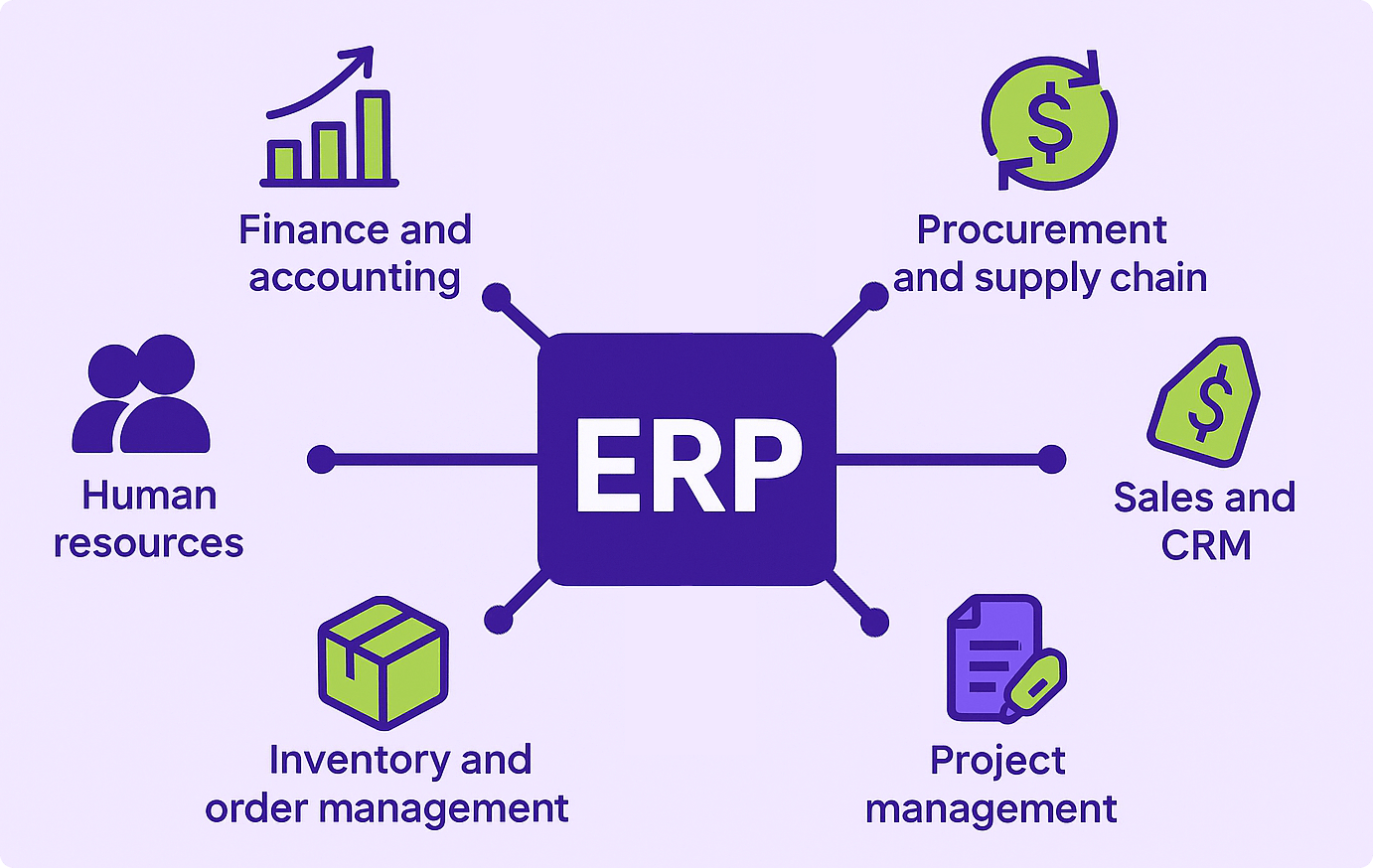
Most ERP systems are built around core modules that address the fundamental needs of any business:
- Finance and accounting handle everything from general ledger and accounts payable to financial reporting and budgeting.
- Human resources manages employee information, payroll, benefits, performance tracking, and workforce planning.
- Procurement and supply chain streamlines purchasing, vendor management, and inventory control.
- Sales and CRM tracks leads, opportunities, customer interactions, and sales performance.
- Project management handles project planning, resource allocation, time tracking, and profitability analysis.
- Inventory and order management tracks stock levels, manages purchase orders, and handles order fulfillment.
Elements of an ERP system
Understanding the core elements of an ERP system helps demystify what can seem like an overwhelming technology platform. Let’s break down the key components that make ERP systems work.
- Central database
Every ERP system is built on a central database, a single source of truth for the whole organization. It prevents departments from working with conflicting data, reducing errors, confusion, and missed opportunities.
- Modular structure
ERP systems are modular, so you can start with what you need. This flexibility also lets you roll out modules in phases, lowering risk and giving teams time to adapt.
- Workflow automation: rules-based intelligence
Automation is one of ERP‘s biggest strengths. Rules can trigger actions automatically, saving time and ensuring consistency in routine processes across the organization.
- Reporting and analytics: insights that drive decisions
ERP provides real-time dashboards and advanced analytics that turn data into actionable insights. Instead of drowning in reports, you get visibility into KPIs, trends, and forecasts that support better decisions.
- User roles and permissions: security and access control
Role-based access ensures employees see only the information relevant to their jobs. This keeps sensitive data secure while making sure teams have what they need to work effectively.
- Integration capabilities: playing well with others
Modern ERP connects seamlessly with tools like CRM, PSA, or industry-specific software through APIs and native integrations. This keeps data consistent while letting you use the specialized tools you rely on.
- Customization and scalability: growing with your business
The best ERP systems adapt to your processes without breaking their core structure. They also scale easily, handling more users, higher transaction volumes, and greater complexity as your business expands.
Types of ERP systems
Not all ERP systems are created equal, and choosing the right deployment model is almost as important as choosing the right functionality. Let’s explore the main types available and what makes sense for different organizations.
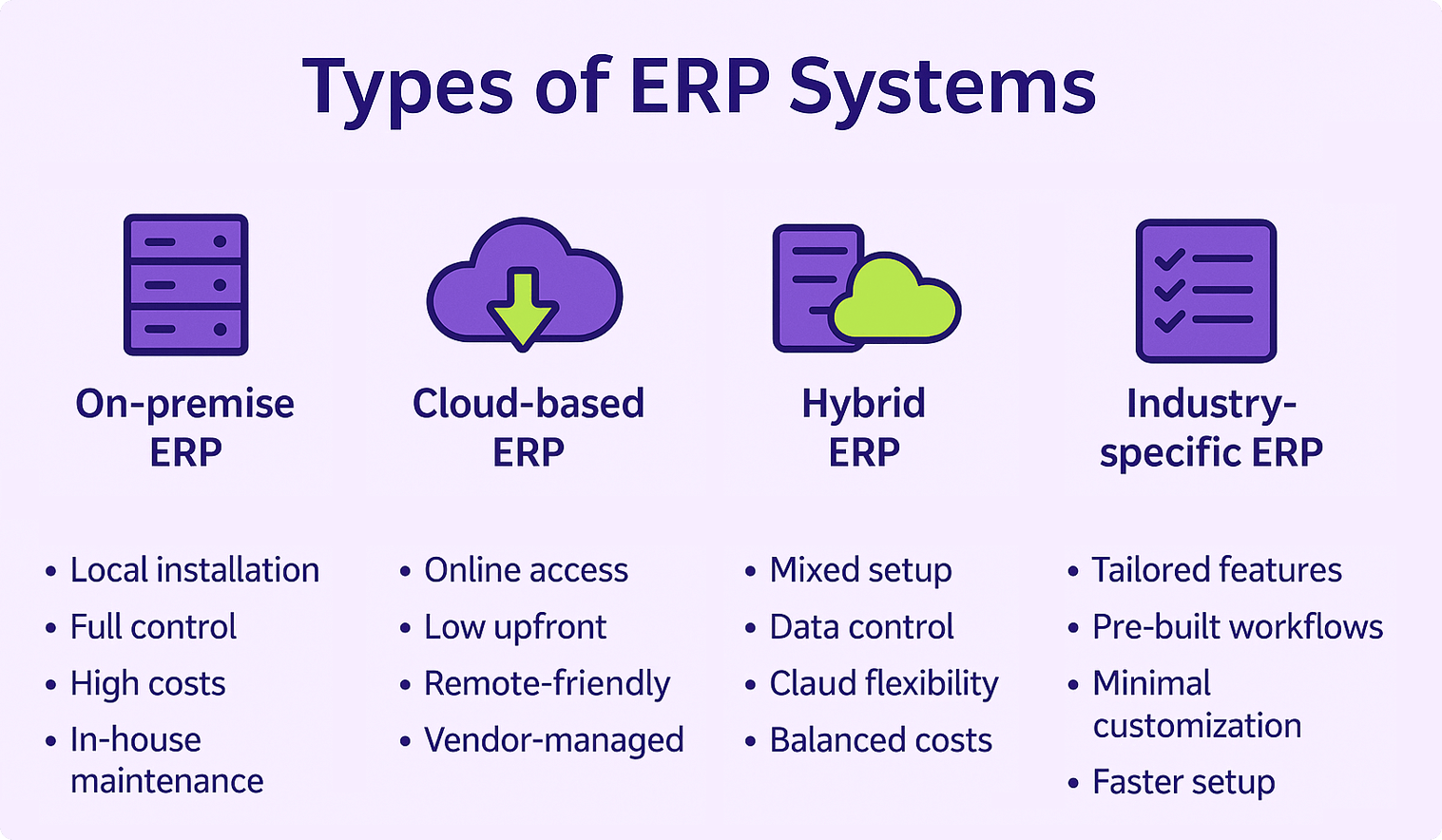
On-premise ERP: full control, full responsibility
On-premise ERP systems are installed locally on your company’s servers and managed by your internal IT team. This gives you complete control over your data, customization options, and system configuration. For organizations with strong IT capabilities and strict data security requirements, on-premises can be the right choice.
However, on-premise systems require significant upfront investment in hardware and ongoing investment in IT staff to maintain, update, and secure the system. You’re also responsible for disaster recovery, system backups, and handling any technical issues that arise.
Cloud-based ERP: accessibility and scalability
Cloud-based ERP systems are hosted by the vendor and accessed through web browsers. This model has become increasingly popular because it reduces the need for internal IT infrastructure and makes the system accessible from anywhere with an internet connection.
Cloud ERP typically operates on a subscription model, which spreads costs over time and includes ongoing updates, maintenance, and support. The vendor handles security, backups, and system updates, allowing your team to focus on using the system rather than managing it.
Hybrid ERP: best of both worlds
Hybrid ERP combines elements of both on-premise and cloud deployments. You might keep sensitive financial data on-premises while using cloud modules for less sensitive functions like HR or project management. This approach allows organizations to maintain control over critical data while gaining the flexibility and cost benefits of cloud deployment for other functions.
Industry-specific ERP: built for your business
Many ERP vendors offer industry-specific solutions tailored to sectors like construction, healthcare, legal services, or professional consulting. These systems include pre-built workflows, reports, and features that address the unique needs of specific industries.
For example, a construction-focused ERP might include modules for job costing, equipment tracking, and compliance reporting that would be irrelevant for a software company but essential for a general contractor.
Comparison of ERP system types
| Factor | On-premise | Cloud-based | Hybrid | Industry-specific |
| Initial cost | High (hardware, licenses) | Low (subscription) | Medium | Varies by vendor |
| Ongoing costs | Medium (maintenance, IT staff) | Predictable monthly fees | Medium | Usually subscription |
| Control over data | Complete | Limited | Partial | Depends on deployment |
| Customization | Extensive | Limited to moderate | Varies by module | Pre-built for industry |
| Implementation time | 6-18+ months | 3-12 months | 6-15 months | 3-9 months |
| IT requirements | High (dedicated team) | Low | Medium | Low to medium |
| Scalability | Manual (requires planning) | Automatic | Mixed | Usually automatic |
| Security responsibility | Your organization | Vendor managed | Shared | Vendor managed |
| Best for | Large enterprises with IT resources | Growing businesses | Organizations with mixed needs | Sector-specific requirements |
ERP software vs. ERP system
While these terms are often used interchangeably, there’s a subtle but important distinction. ERP software refers to the actual applications, programs, and digital tools you install or access. ERP system encompasses the entire implementation–the software plus your business processes, data structures, user training, governance policies, and organizational changes that make it all work together.
Think of it this way: you can buy ERP software off the shelf, but you build an ERP system through careful implementation, configuration, and change management. The software is just the foundation; the system is what actually transforms how your business operates.
ERP vs PSA
While ERP systems try to manage all business functions across any industry, Professional Services Automation (PSA) platforms like Birdview PSA are laser-focused on the specific needs of service-based businesses. The key difference is focus: ERP is comprehensive but generic, while PSA is specialized but perfectly suited for project-based work.
ERP systems excel at manufacturing, inventory management, and complex supply chains, but often require extensive customization for service businesses. PSA platforms are built from the ground up for project management, resource allocation, time tracking, and client billing.
Further reading
How to choose an ERP system?
Choosing an ERP system is one of the most important technology decisions your organization will make. Get it right, and you’ll have a platform that supports growth for years. Get it wrong, and you’ll be dealing with the consequences for just as long.
- Start with a clear assessment of your needs. Before looking at vendors, understand what you’re trying to accomplish. A 50-person consulting firm has very different needs than a 500-person manufacturing company.
- Involve all key stakeholders early. ERP affects every part of your organization, so include representatives from IT, finance, operations, HR, and other departments that will use the system regularly.
- Think integration, not isolation. Consider how the ERP will integrate with your existing tools. Some systems play well with others; some expect to be your only system.
- Evaluate customization vs. configuration. Configuration is generally safer and easier to maintain, while customization offers more flexibility but creates long-term maintenance challenges.
- Research the vendor relationship. Check their reputation, financial stability, update frequency, and customer support quality. Talk to other customers with similar needs.
- Consider total cost of ownership. Factor in implementation, training, maintenance, customization, and upgrade costs, not just the sticker price.
Checklist: Is your organization ready for ERP?
Before diving into ERP selection and implementation, take an honest look at whether your organization is truly ready for this level of change. Here’s a practical checklist to help you assess your readiness. If you can’t check most of these boxes, it might be worth addressing these foundational issues before moving forward with ERP.
What this checklist takes into consideration:
- Growth indicators
Current systems can’t support growth, new locations/services strain existing processes, and manual workarounds are becoming routine.
- Data and process issues
Siloed data makes it hard to see the full business picture. Unreliable forecasting, resource planning, or profitability tracking signals ERP readiness.
- Organizational readiness
Leadership is aligned on transformation goals, executive champions are identified, and key employees are willing to participate in implementation.
- Resource availability
You have time, budget, and staff who can dedicate significant effort to implementation, training, and change management.
- Process maturity
Core workflows are mapped and documented, and you’re open to adjusting processes to fit ERP best practices rather than forcing customization.
Implementing an ERP system
ERP implementation is where theory meets reality, and reality can be challenging. Here’s what a thoughtful implementation process looks like:
Step 1: Pre-implementation: setting the foundation
Before signing contracts, define measurable goals and map processes as they work, not just how they should. Choose a vendor carefully, but also assemble an internal team that understands both business operations and technology, and can bridge communication across stakeholders.
Step 2: Project planning: realistic timelines and expectations
Build a timeline with clear milestones and buffer space for delays. Assign roles and responsibilities upfront and establish decision-making rules. Risk assessment is essential. Issues like data migration errors, integration problems, staff resistance, or scope creep need mitigation plans.
Step 3: Data migration: cleaning house before moving
Data migration often takes the most effort. Use it as a chance to clean up duplicates and inconsistencies so you don‘t bring old problems into the new system. Plan for multiple test runs to identify errors, prepare users, and ensure a smooth final cutover.
Step 4: Customization and configuration: finding the right balance
Configure ERP to match core processes, but avoid over-customization that adds cost and complexity. In many cases, it‘s better to align workflows with ERP best practices rather than forcing the system to replicate inefficient methods. Document all configuration decisions for future reference.
Step 5: Training: investing in user adoption
Training should be role-based and practical, showing users how to perform daily tasks in the new system. Combine classroom sessions, hands-on workshops, and quick job aids with ongoing support after launch. Effective training is one of the biggest drivers of adoption.
Step 6: Go-live and testing: choosing your strategy
Organizations can roll out ERP in phases or go live all at once. Phased approaches spread out risk but take longer; big-bang implementations are faster but riskier. In both cases, extensive testing is non-negotiable.
Step 7: Post-launch support: the real work begins
Go-live marks the start, not the end. Provide strong support in the first weeks, monitor system performance, and gather feedback for adjustments. Long-term success comes from treating ERP as a living system that evolves with business needs.
Choosing an all-in-one solution instead of a traditional ERP
While traditional ERP systems can certainly solve many problems, there’s an important question to consider: do you need the complexity and overhead of a full enterprise system, or would an all-in-one business management solution serve you better?
For many growing businesses, especially in professional services, consulting, marketing, and project-based industries, traditional ERP can be overkill. This is where modern all-in-one solutions like Birdview PSA shine. Instead of forcing you to adapt your business to fit a traditional ERP framework, these platforms are built specifically for the way service businesses work.
Birdview PSA is laser-focused on the needs of project-based businesses. You get robust project management, resource planning, time tracking, and financial management within a single platform. Explore Birdview PSA‘s features today!

